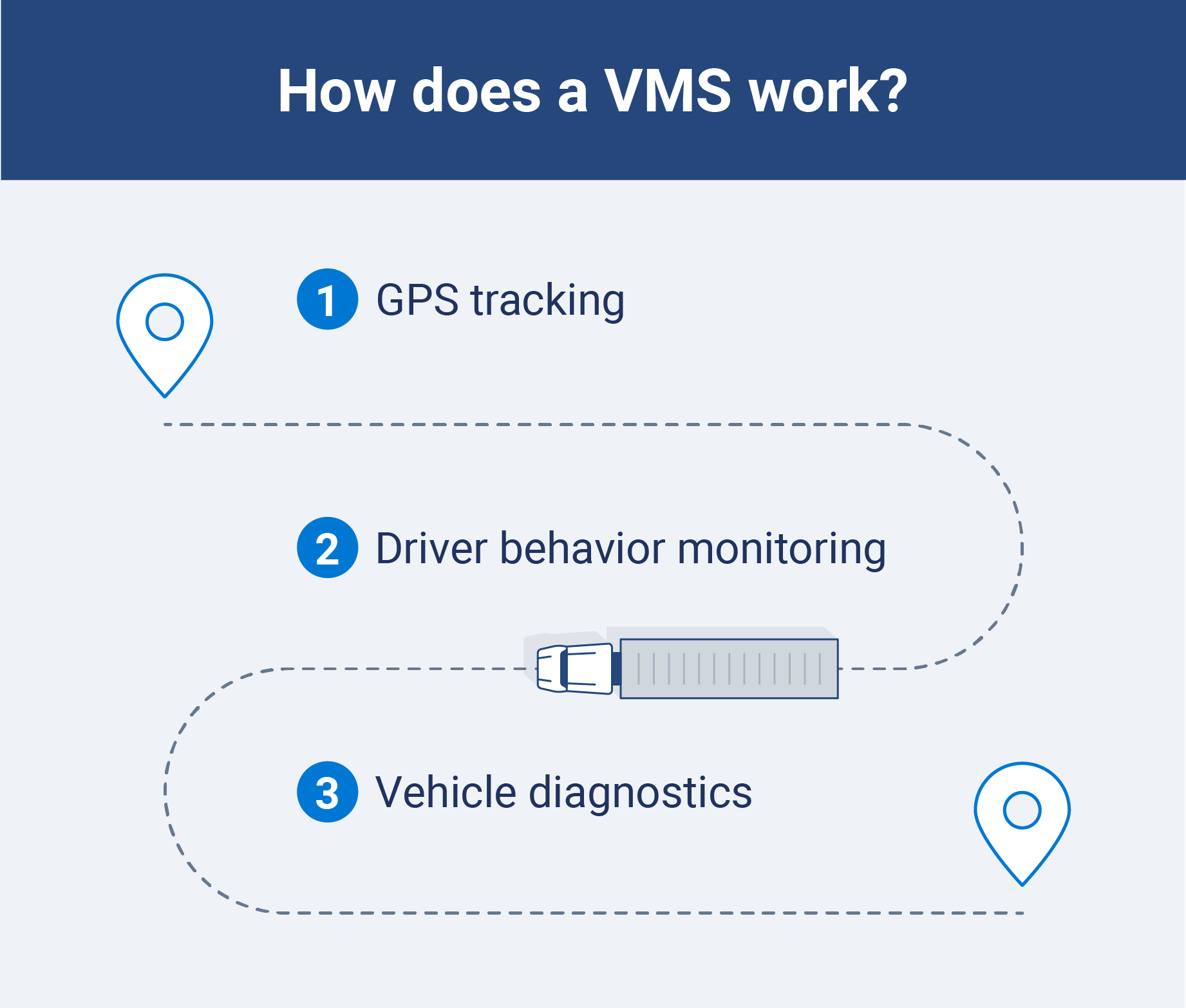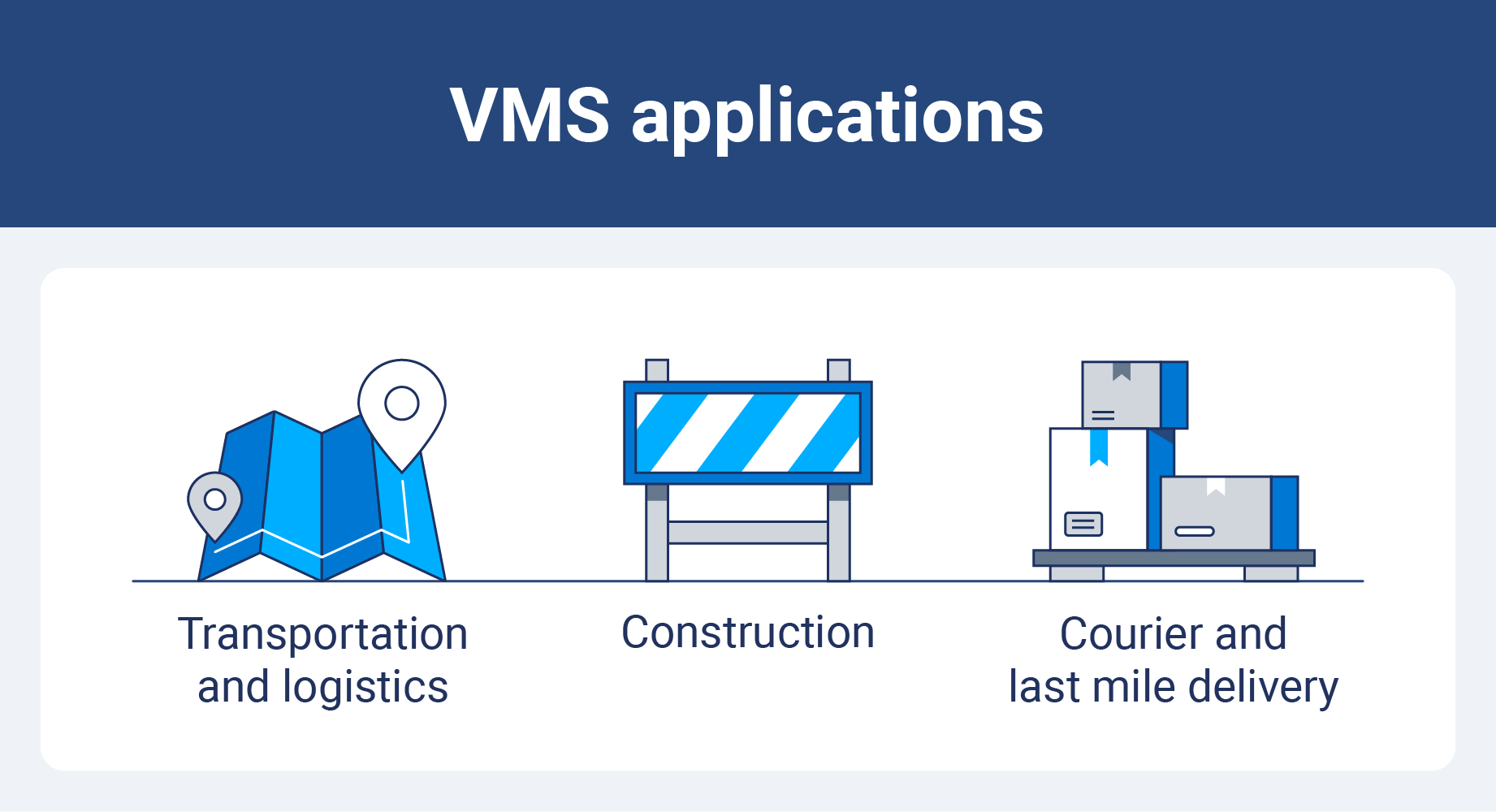What is a vehicle monitoring system (VMS) and how does it work?
As a fleet owner, you must consider vehicle monitoring systems (VMS). These systems will turbocharge your operations, so you should consider one.
By Geotab Team
May 7, 2025

Key Insights
- Vehicle monitoring systems (VMS) are beneficial for fleet managers who want to improve safety and efficiency in haulage operations.
- An effective VMS can be a great investment and will vastly improve fleet management efficiencies.
- VMS presents driver behavior information, which fleet managers can use to improve safety.
If you manage a fleet of commercial vehicles, the importance of an efficient vehicle monitoring system (VMS) cannot be understated. Vehicle monitoring systems are an integral aspect of managing enterprise fleets due to the rich real-time data sets that they provide.
A VMS can provide an array of powerful integrated tools to monitor your vehicles, such as geofencing, which allows you to observe vehicle activity in specific areas and receive alerts on pre-defined behaviors.
This system can be the difference between your delivery schedule running efficiently and on time and your operators driving your vehicles safely and compliantly.
In this article, we’ll talk about the benefits of implementing a vehicle monitoring system, plus its core features.
What is a vehicle monitoring system (VMS)?
A vehicle monitoring system is a suite of tools that allows you to track the GPS location of your fleet, monitor driver behavior and reduce fuel consumption. You can improve your company's reputation and safety by integrating in-vehicle sensors and remotely managed software.

Modern-day VMS and vehicle tracking devices are essential for fleet owners. They provide many benefits, focusing on logistics efficiency and safety.
A VMS can prevent accidents by tracking bad driver behaviors, such as exceeding the speed limit or harsh braking. When remediated, this can ultimately save lives.
These systems also reroute driver routes to maintain efficient dispatch and avoid congestion, enabling time- and fuel-saving efficiencies.
Core features of a VMS
While a VMS mostly addresses fleet safety and efficiency, some systems also offer functionality. Here are the core features you can expect from a good VMS:
GPS tracking
If you’re in the fleet management business, you must know where your vehicles are. Effective dispatch and routing can be the difference between missed dispatches and deliveries. Thanks to modern technology that leverages the power of GPS tracking, you as a business no longer have to be at the mercy of unpredictable roadblocks.
GPS tracking allows you to optimize your route in the event of such disruption to ensure smooth and efficient routing. Moreover, geofencing allows fleet managers to create a virtual boundary around a location, identify improvement measures or even send an alert if something’s wrong.
Get advanced GPS tracking with Geotab’s vehicle-tracking device.
Driver behavior monitoring
An effective VMS can be a powerful driving monitor for unsafe or undesired behaviors such as:
- Speeding
- Harsh braking
- Excessive idling
- Tailgating
- Rough cornering
- Drowsiness
Fleet managers can monitor such behaviors and use the data to alleviate undesired behaviors by assessing shift length, providing training or undertaking disciplinary measures.
Vehicle diagnostics
Vehicle diagnostics are integral to a robust logistics operation, and a solid VMS allows fleet managers to conduct remote diagnostic checks before they compound into more serious problems.
Such diagnostic checks may include:
- Tire pressure monitoring
- Engine diagnostics
- Maintenance alerts
- Fuel usage
- Overall vehicle health
These aspects are unsafe and could result in hefty fines if vehicles undergo a DOT audit and fail due to inadequate diagnostics.
Benefits of implementing a VMS
By now, you’ll know some of the core features of a VMS and some of the main benefits enterprises will realize when implementing such a system. Such features are just the tip of the iceberg, but let’s elaborate on the main benefits of implementing a VMS:

Improves driver safety
A VMS can track and analyze driver behavior, which is paramount to any business that oversees a fleet. As a business, you need reassurance that your drivers are well-rested and that when they drive your company vehicles, they do so safely and competently.
The last thing you want as a business is for one of the involved vehicles to be caught up in a collision, which has safety and legal implications for all parties involved.
A VMS will allow you to spot worrying trends, such as consistent speeding, sharp braking and tailgating. This data will allow you to evaluate countermeasures, such as training or disciplinary measures.
Enhances fleet efficiency
It’s the ability to keep a close eye on your fleet's geographical locations, and it can be a highly powerful technology for improving the efficiency of dispatch and delivery by rerouting the fleet outside of road closures and traffic delays.
GPS tracking can help ensure that the workforce and haulage operations are exactly where they expected.
Improves asset utilization
A VMS tracks idle time and identifies opportunities for improvement. For example, during such idle time, fleet maintenance due to maintenance of the fleet to ensure that it does not conflict with dispatch and delivery time.
Captures advanced data
A VMS or in-vehicle camera monitoring system can be the nervous system of your fleet and haulage operation by capturing and analyzing many data points, such as an engine's RPM and fuel consumption. Such information is hugely useful for predictive maintenance.
Such data allows you as the enterprise to optimize for maximum efficiency and ensure that vehicle maintenance is scheduled during idle time and well ahead of issues occurring.
Streamlines compliance and regulations
Your VMS can be a big help when it comes to showing compliance with HOS and IFTA fuel tax.
A system can be configured to alert you to discrepancies and provide all the data points necessary to ensure compliance across your fleet.
Common VMS challenges
Implementing a VMS across your fleet can feel like a daunting step and as an enterprise, there are some common challenges that you need reassurance on.
Data security
A VMS may contain commercially sensitive information and can be an endpoint for the rest of your enterprise.
As such, it’s important to have robust data and cybersecurity protection and that the system is secure by design. Key requirements to look out for are end-to-end encryption, multi-layered authentication and vigorous access control hierarchies.
Initial setup costs
Another challenge that enterprise owners and operators face is the inevitable upfront costs that are warranted for procuring hardware, software and expertise in getting set up with a VMS.
If the VMS is correctly configured, then these costs should be seen as an investment rather than an overhead cost due to the fleet management efficiencies that will be realized.
Driver acceptance
It will come as no surprise that employees may view a truck driver monitoring system with suspicion and paranoia. Many drivers may resist being monitored, which can upset performance and workforce morale.
Education is critical to overcoming this hurdle. You’ll want to clearly communicate that the monitoring is purely for safety purposes.
Real-world applications of VMS
Whilst it’s easy to talk about the benefits and features of a truck monitoring system, it’s important to stress real-world applications of the technology and how it’s helped businesses in various industries.
Two industries that have fully embraced the power of vehicle monitoring systems include those in logistics and construction.

Transportation and logistics
The benefits of optimizing delivery routes and fleet utilization in the logistics industry are obvious due to the time and fuel-saving efficiencies.
Industries where sensitive goods are handled in haulage, such as food and pharmaceuticals, have been prominent beneficiaries of VMS implementation, most notably by executing cold chain logistics, enabling managers to control temperatures across their entire fleet of vehicles as efficiently as possible.
Construction
The construction industry has also contributed to the VMS revolution, using the systems to track equipment and assets, monitor driver hours of service (HOS) and vastly improve job site safety.
Get enhanced vehicle data tracking with a VMS
It might sound like rolling out a VMS vehicle monitoring system is a no-brainer, and to a degree, it is:
- It can help lower insurance premiums by tracking driving habits
- It can assess where fuel is wasted and optimize
- It can coach drivers on positive driving habits
While VMS and vehicle monitoring devices involve upfront investments, they’re here to stay.
Prepare your fleet for the future
Advanced GPS vehicle tracking devices can be the difference between a fledgling transportation enterprise and a thriving fleet of the future.
Whether you’re involved in EV fleet management or concerned about delays in dispatch and delivery, a vehicle monitoring system is a crucial investment.
Subscribe to get industry tips and insights
Frequently Asked Questions
An interior car monitoring system monitors the inside of a car to enhance safety for the driver and their passengers.
Sensing devices such as cameras and radar can alert people to hazards, such as unclipped seat belts and break-in attempts.
A vehicle monitor detects dangerous driving habits, such as speeding and aggressive braking. Fleet managers are informed of these behaviors to alleviate them and improve safety.
GPS (global positioning system) refers to the satellite-based technology that allows drivers to determine their location via satellite navigation systems.
A VMS will also utilize GPS technology to locate its vehicles and the geographical location of its drivers. GPS is merely a technology that’s an integral component of a VMS.
The cost of an in-vehicle monitoring system can vary widely depending on the system and feature list that an enterprise wishes to utilize.
The size of a fleet, too, affects the cost of a VMS system, which can range from as little as $15 per vehicle every month to advanced devices that cost hundreds of dollars.
The Geotab Team write about company news.
Table of Contents
Subscribe to get industry tips and insights
Related posts

The $4B Crisis: Video Intelligence as the Answer to Fleet Distraction
December 2, 2025
3 minute read

The True Cost of Cargo Theft: When Customer Trust is on the Line
November 24, 2025
2 minute read

Telematics device cost: Key factors that determine pricing
November 19, 2025
5 minute read

Law enforcement technology: Four trends to know for 2026
November 7, 2025
6 minute read

Four seasons of fleet intelligence with Geotab's Public Works solution
November 7, 2025
2 minute read

Infographic: What are the ripple effects of school bus driver turnover?
November 6, 2025
1 minute read